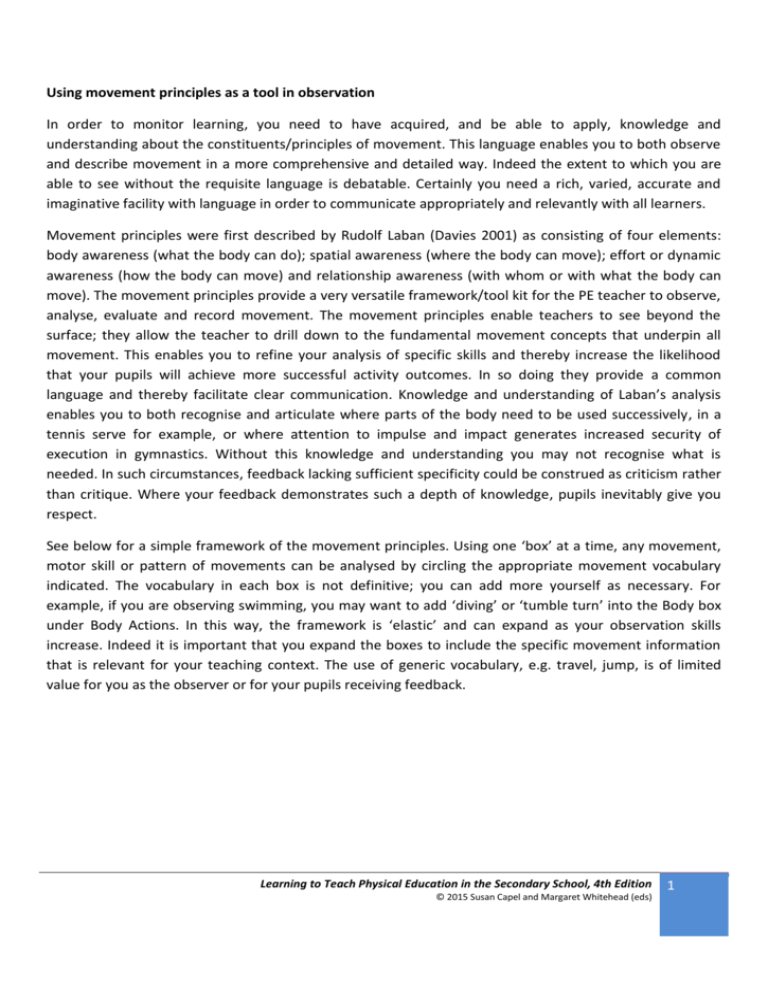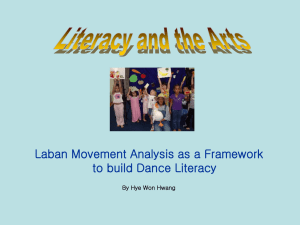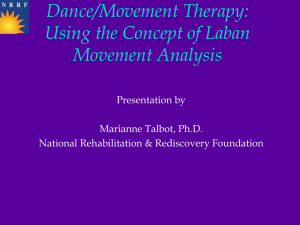Using movement principles as a tool in observation In order to
advertisement

Using movement principles as a tool in observation In order to monitor learning, you need to have acquired, and be able to apply, knowledge and understanding about the constituents/principles of movement. This language enables you to both observe and describe movement in a more comprehensive and detailed way. Indeed the extent to which you are able to see without the requisite language is debatable. Certainly you need a rich, varied, accurate and imaginative facility with language in order to communicate appropriately and relevantly with all learners. Movement principles were first described by Rudolf Laban (Davies 2001) as consisting of four elements: body awareness (what the body can do); spatial awareness (where the body can move); effort or dynamic awareness (how the body can move) and relationship awareness (with whom or with what the body can move). The movement principles provide a very versatile framework/tool kit for the PE teacher to observe, analyse, evaluate and record movement. The movement principles enable teachers to see beyond the surface; they allow the teacher to drill down to the fundamental movement concepts that underpin all movement. This enables you to refine your analysis of specific skills and thereby increase the likelihood that your pupils will achieve more successful activity outcomes. In so doing they provide a common language and thereby facilitate clear communication. Knowledge and understanding of Laban’s analysis enables you to both recognise and articulate where parts of the body need to be used successively, in a tennis serve for example, or where attention to impulse and impact generates increased security of execution in gymnastics. Without this knowledge and understanding you may not recognise what is needed. In such circumstances, feedback lacking sufficient specificity could be construed as criticism rather than critique. Where your feedback demonstrates such a depth of knowledge, pupils inevitably give you respect. See below for a simple framework of the movement principles. Using one ‘box’ at a time, any movement, motor skill or pattern of movements can be analysed by circling the appropriate movement vocabulary indicated. The vocabulary in each box is not definitive; you can add more yourself as necessary. For example, if you are observing swimming, you may want to add ‘diving’ or ‘tumble turn’ into the Body box under Body Actions. In this way, the framework is ‘elastic’ and can expand as your observation skills increase. Indeed it is important that you expand the boxes to include the specific movement information that is relevant for your teaching context. The use of generic vocabulary, e.g. travel, jump, is of limited value for you as the observer or for your pupils receiving feedback. Learning to Teach Physical Education in the Secondary School, 4th Edition © 2015 Susan Capel and Margaret Whitehead (eds) 1 Laban’s analysis of movement – a tool box for teaching BODY SPACE Bend/stretch/twist (fundamental to all movements) Actions that: travel, e.g. run, dash, gallop, sprint turn, e.g. pivot, spin, spiral, rotate jump, e.g. skip, leap, vault, bound (five varieties) gesture, e.g. contract, extend, spiral, arch transfer the weight of the body, e.g. roll, cartwheel, fall, slide are still, e.g. stop, freeze, balance, halt Body parts that: support, lead, are isolated and/or emphasised can be used simultaneously or successively general space/personal space size of movements levels: low/medium/high shape in space: curved/straight directions: up/down, forward/backward, right/left (open/close) planes (2D movements): door/vertical plane (high/low + open/close); table/horizontal plane (open/close + forward/backward); wheel/sagittal plane (forward/backward +high/low) diagonals (3D movements): e.g. high+forward+open to low+backward+close pathway: linear (becomes angular)/circular (becomes twisted) on the floor and/or in the air Body shape: small, twisted, wide and/or thin symmetrical/asymmetrical EFFORT/DYNAMICS RELATIONSHIPS Weight, space, time and flow are the names given to four continua. Each continuum has two extremes and a range of possibilities between them. Relating to the space: floor; walls; pitch; arena; court; stage Relating to objects: balls; hoops; goals; weights; benches; mats; horse; climbing frame Time: slow/sustained/lingering fast/sudden/rapid/quick accelerating/decelerating Weight/tension: strong/firm/maximum tension light/soft/fine/minimal tension relaxed/no tension Space: direct/piercing/focused multidirectional/flexible/unfocused Flow: bound/restrained/stoppable free/unrestrained/ongoing Each continuum provides single motion factors, e.g. Relating to people: solo: o alone o alone in a mass duo: o copying/mirroring o leading/following o meeting/parting/passing o action reaction (question/answer) o unison/canon Small/large group/whole class: groups, however large, can deploy the same relationships as duos, although groups offer the additional possibility that: a number of different relationships can occur simultaneously, creating inter-group relationships numbers in groups can be used variously, e.g. a group of six might include one solo, one duo and a Learning to Teach Physical Education in the Secondary School, 4th Edition © 2015 Susan Capel and Margaret Whitehead (eds) 2 sudden which can be combined with one other (sudden+swift), two other (sudden+swift+bound) or three other (sudden+swift+bound+direct) motion factors. trio groups can create a greater range of formations, e.g. lines, wedges, circles Spatial relationships: over; under; around and through, which may/may not involve contact and/or lifts Laban’s analysis: a framework for observing movement Laban’s analysis provides a very usable tool for observation. There is no right or wrong when using this tool; however, the structure gives you a framework within which to observe pupil learning. All observations will relate to the intended learning outcomes (ILOs) for the lesson. Planning requires the teacher to identify teaching/observation points in relation to the ILOs. Teaching/observation points provide prompts for the teacher. Having identified a task that will facilitate the ILO, the teacher lists the points s/he would expect to see if the learning is taking place. If the teacher does not see these points, then s/he will articulate the relevant points in order to assist/reinforce/clarify the learning. Laban’s analysis provides a framework for developing observation and feedback designed to support/challenge all pupils to realise their learning potential. Whether you are teaching skills or tactics, Laban’s analysis assists observation. Moreover, Laban’s analysis provides support for the teacher new to planning, alongside the more experienced teacher eager to challenge all pupils to produce the highest-quality work. Examples of the use of Laban’s analysis for planning, observation and feedback Using the elastic boxes framework as an observation tool opens your eyes to your pupils’ movement vocabulary and movement mastery. You can see where they lack experience and thus are able to address this in your future planning. Of course, all observations will relate to the ILOs for the lesson. Rigorous planning should provide prompts for observations in relation to the lesson ILOs. Indeed Laban’s analysis supplies the tools for rigorous planning, observation and feedback (teaching). For example: Learning to Teach Physical Education in the Secondary School, 4th Edition © 2015 Susan Capel and Margaret Whitehead (eds) 3 ILO: pupils will be able to transfer their weight quickly, efficiently and safely when rolling Task Weight transference/ sideways roll from standing to standing Organisation Teacher demonstration – safety Do together Observation/teaching points What: weight over support, body parts aligned. Simultaneous bending of body parts. Transfer the weight successively from left shin to thigh, hip, back to right hip, thigh, shin, until upright (crouched) with weight on left foot. Use left hand for support if required. Complete one rotation. As confidence develops, add a jump to start. Observe class Teaching points on the board Where: down (as low as possible) – across – up. Thin – small – thin body design in the space. Linear – circular – linear air pattern. Linear pathway on the floor. Body as small as possible whilst rolling. As confidence develops, add a hold, a wide shape, to finish. How: controlled descent. Allow gravity to provide impulse for roll. Maintain momentum until weight is over left foot. Use right hand for additional impetus if required. As confidence increases, accelerate through the descent and decelerate through the ascent. With whom/what: Ensure that you are working on your own in a space. Remain facing the front throughout. As confidence increases, vary relationship with the room whilst retaining awareness of your peers – safety. You should note that all of the teaching/observation points relate directly to the ILOs. You should be aware from the above that Laban’s analysis provides you with a tool to with which to differentiate. The analysis enables you to start with the more fundamental features of the movement experience, increasing your expectations as you see your pupils’ confidence increase. Learning to Teach Physical Education in the Secondary School, 4th Edition © 2015 Susan Capel and Margaret Whitehead (eds) 4 With experience it may not be necessary to plan in such detail. The four categories of Laban’s analysis may provide sufficient prompts for you to analyse/observe what the body is/should be doing; where in the space, how and with whom or what the body is/should be moving. You should know that Laban’s analysis is useful for tasks which are more pupil centred as well as teacher centred. For example, in dance composition, having used Laban’s analysis to ensure that movement responses are accurate, what, where, how and with whom/what can be used to prompt more imaginative responses, e.g. Can you make X bigger, decelerate, freeze with impact, emphasise the torso … ? In a cooperative learning episode, selected elements of Laban’s analysis can be used to support groups in their responses to tasks. As a student teacher your ILO might be concerned with teaching a simple skill. For example, you may have observed that the majority of your class are not hitting the tennis ball with control because they are not moving their feet soon enough. Using Laban’s analysis to help you identify the requisite observations/teaching points, therefore, might look like this: ILO: pupils will be able to move their feet in relation to the ball Task Organisation Observation/teaching points Running to the Teacher ball demonstration What: alert position (bend knees/shift weight); focus (watch the ball); anticipate where it will land; run to the ball (get there before the ball bounces). Pairs – one feeds the other (change over roles when indicated) Observe class Where: straight pathways; run forwards/backwards/ sideways as necessary. How: adjust speed to arrive in a secure position before the ball bounces. With whom/what: watch the ball from when it leaves your partner’s hand until it bounces; align yourself sideways on to the ball as it bounces. Learning to Teach Physical Education in the Secondary School, 4th Edition © 2015 Susan Capel and Margaret Whitehead (eds) 5



![afl_mat[1]](http://s2.studylib.net/store/data/005387843_1-8371eaaba182de7da429cb4369cd28fc-300x300.png)




